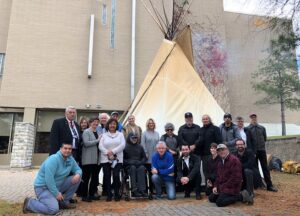Joseph Arvay: Gaa-gnoodmawaat nenaakwiinjin – ‘He pleaded for those who are fighting back’

By Catherine Murton Stoehr
Success in the Robinson Huron Treaty litigation rests on convincing a Canadian judge that the perspective of the Anishinabek who negotiated the treaty is both relevant to understanding the nature of the agreement and meaningfully accessible to a court in 2020. Queen’s Council Joseph Arvay, who unexpectedly began his journey to the ancestors this month after suffering a heart attack, got the job done.
Mike Restoule of Nipissing First Nation chairs the Robinson Huron Litigation trust and remembers when he first met Mr. Arvay,
“I was impressed by him right off. He was very interested in getting to know me. He showed me respect right from the start.”
The Robinson Huron legal team of Diane Corbiere and Don Worme, headed by David Nahwegahbow, assembled an imposing roster of knowledgeable expert witnesses including Elders, language speakers, and historians to present the Anishinabek perspective on the treaty. Mr. Arvay’s role was to focus the court’s attention on their words and prevent it from dismissing their testimony as antiquated, merely “cultural”, or otherwise irrelevant.
In one way or another, Mr. Arvay spent his career reminding Canada that the loudest voices and opinions are not always the truest or most just.
For too long, society collectively ignored the rights and safety of LGBTQ2S+ folks but Joe Arvay brought them before the Supreme Court not once, or twice, but four times and now they are protected.
The voices of our sisters and brothers confined to solitary confinement for hundreds of days together found a megaphone in Mr. Arvay who convinced the British Columbia Courts to rein in the practice.
Those who live their lives among the poor embrace a philosophy of harm reduction. When the strident cries of moralism nearly closed a safe injection site in Vancouver, Mr. Arvay defended the facility. An action worker says he has saved hundreds of lives.
Sex trade workers endangered by a mess of incoherent prostitution laws gained protections when Mr. Arvay helped them tell the Supreme Court of Canada about their lives.
In perhaps his most famous case, Mr. Arvay argued that the perceptions and experiences of people with chronic pain, or degenerative diseases who wished to control the time of their deaths cannot be dismissed because others with similar afflictions feel differently, convincing the Supreme Court of Canada to affirm the right to physician-assisted suicide.
One of Mr. Arvay’s legal partners, Catherine Boies Parker, explained his approach.
“Joe believed that the law should do good and take care of vulnerable people, and if the law doesn’t do that, then that’s ok, we’ll make it do that.”
She recounted what that looked like in practice at the Robinson Huron trial.
“He got so much out of the Crown’s witnesses [the people defending the position that the Treaty is being honoured already]. He got Ontario’s main witness to agree that the annuity as it is currently framed is not what would have been understood by the Anishinabek at the time.”
Proof of Mr. Arvay’s success in centring the Anishinabek perspective may be found in the written judgement finding for the Anishinabek in the first phase of the trial, in which Justice Patricia Hennessy cited the testimony of Anishinabek Elders and historians more than 20 times.
Reflecting on the future of the treaty case without its lead litigator, Boies Parker expressed confidence.
“The hardest part of litigation like this is the first part of the trial which we’ve done now. The judge has allowed all the evidence [we offered] about the interpretation of the treaty.”
Though appeals may be ahead, Boies Parker said that factual findings of the trial judge (initial judge) with regard to evidence, in this case, the Anishinabek perspective, and how it informs the treaty, do not generally get overturned at appeal.
“Arranging the evidence, the thing Joe did really well, he had a chance to do that. The Anishinabek perspective is so important, and the case of the Anishinabek is so powerful that it has a momentum now that will continue even with him gone. What he achieved in the first round and the force and the power of the truth behind the Anishinabek view of the treaty will carry forward.”
David Nahwegahbow echoed similar sentiments about Mr. Arvay.
“[He] deserves utmost credit for the success of the case in stages one and two. These successes have set the stage for the third trial on compensation and ultimately reconciliation with the Crown as originally intended by the Crown and Anishinaabe treaty partners.”
Though Mr. Arvay did not know that his work on the Robinson Huron Trial would be the final contribution of his storied career, Boies Parker recalled his thoughts on the case.
“He considered this to be one of the most important cases of his career and he saw it as an honour to act for the Anishinabek and his honour increased the more time he spent on it. He enjoyed learning about the Anishinabek perspective and the Anishinabek people, and he continued to learn throughout the trial; and that was rewarding, to see how his understanding developed.”
Joe Arvay’s wife Connie Addario asked that a message of thanks be relayed to the community members, Elders, cooks, Fire Keepers, and leaders who took the time to host and educate Mr. Arvay and his colleagues. She wanted them to know that Mr. Arvay appreciated all that was done for them and was deeply grateful for their hospitality.
For now, the grief is fresh and sharp. Whatever victories have been or may lie ahead, Mike Restoule spoke the truth that so many are experiencing.
“He was a true friend. I am missing him terribly.”
Special thanks from the author: Miigwetch to Mary Ann Corbiere of Wiikwemkoong Unceded Territory for sharing her time and skill to work out an Anishinaabemowin rendering of Joseph Arvay’s vocation.


